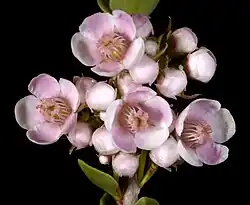Scholtzia involucrata
| Spiked scholtzia | |
|---|---|

| |

| |
| Scientific classification | |
| Kingdom: | Plantae |
| Clade: | Tracheophytes |
| Clade: | Angiosperms |
| Clade: | Eudicots |
| Clade: | Rosids |
| Order: | Myrtales |
| Family: | Myrtaceae |
| Genus: | Scholtzia |
| Species: | S. involucrata
|
| Binomial name | |
| Scholtzia involucrata (Endl.) Druce
| |
Scholtzia involucrata, commonly known as spiked scholtzia, is a shrub species in the family Myrtaceae that is endemic to Western Australia.[1]
The erect, spreading to decumbent shrub typically grows to a height of 0.2 to 1.5 metres (0.7 to 4.9 ft).[1] The evergreen leaves are 4 to 9 millimetres (0.157 to 0.354 in) in length.[2] It blooms between November and May producing pink-white flowers.[1] Each flower has a diameter of 8 mm (0.315 in).[2]
The species was first formally described by the botanist George Claridge Druce in 1917 as part of the work Nomenclatorial Notes: chiefly African and Australian as published in The Botanical Exchange Club and Society of the British Isles Report for 1916 There are three known synonyms; Baeckea obovata, Scholtzia obovata and Baeckea involucrata.[3]
It is found on sand plains and ridges along the west coast in the Wheatbelt and Peel regions of Western Australia where it grows in sandy soils.[1] The plant is part of the understorey in kwongan or Banksia woodland communities.[2]
References
- ^ a b c d "Scholtzia involucrata". FloraBase. Western Australian Government Department of Biodiversity, Conservation and Attractions.
- ^ a b c Margaret G. Corrick; Bruce Alexander Fuhrer (2009). Wildflowers of Southern Western Australia. Rosenburg Publishing. ISBN 9781877058844.
- ^ "Scholtzia involucrata (Endl.) Druce". Atlas of Living Australia. Global Biodiversity Information Facility. Retrieved 6 November 2018.